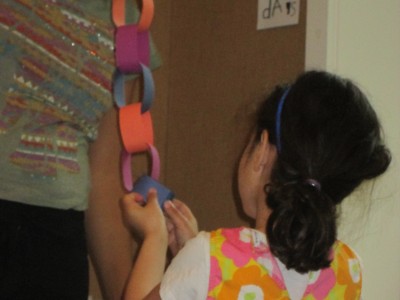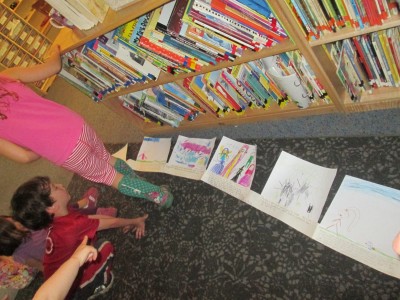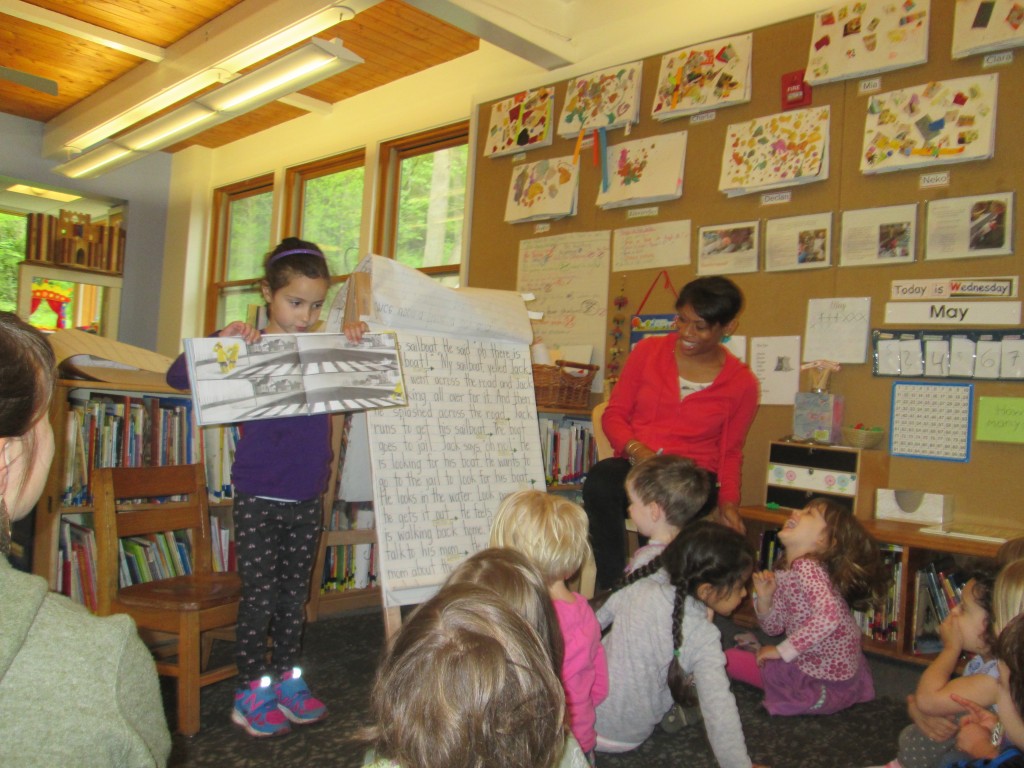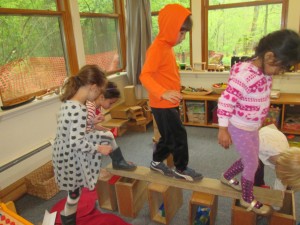“I knew it was going to tip over”: Measurement, Geometry, and Probability in Play

Not only are we enjoying the remaining weeks of school together, we’re measuring them in two very different ways. First, as you may have heard, every morning our learners count the number of links left on our paper chain to figure out the number of days left until school ends, tearing off one link each day. Last week we gasped with astonishment after we counted 15 paper links! In addition to the paper chain countdown, we started Story of the Day, which is a literacy- and math-infused opportunity for each of our learners to have the special job of drawing and telling a story every day until the end of the school year. The stories are attached so that they form a linear record of what our nursery authors chose to communicate as important and meaningful that day. “When people share personal stories from the day, they express themselves, their creativity, and their own experience of life. They affirm the validity of their experience, they gain confidence, they find their own voice, and they also find the edge of their knowledge and become inspired to go back out and learn more” (p. 299, Coyote’s Guide to Connecting With Nature, 2010). Some of the stories are nonfiction; some are fiction; and some are “a little of both.” After a child shares the Story of the Day, it is so exciting to notice the how the length of the rolled up stories is growing longer each day. We plan to present a read-aloud of the “Stories” of the Day to nursery families and friends on our last day of school.
Measurement, geometry, and data analysis and probability concepts emerged during our water exploration, our gardening and habitat study, and lots of block building.
 Tearing off one link of our paper chain countdown.
Tearing off one link of our paper chain countdown. Composing a Story of the Day.
Composing a Story of the Day. The length of our one long story of stories.
The length of our one long story of stories.
Water Exploration: Measurement, Geometry, and Probability
“I predicted it would sink but it floated!”–Miles
We continued our water exploration from last month by applying what we observed about the properties of water while performing Sink or Float? tests at the water table. The learners chose to test a wide array of materials, such as cork, meat and vegetable trays, straws, stones, toy cars, cardboard, and aluminum foil. First they shared their predictions. Their experiments led them to compare heavier versus lighter weight, length, and shape of an object. At the same time, as they wondered which materials were “seaworthy” enough for building a boat, they explored the concept of buoyancy, much like Archimedes, who discovered that if the weight of the object being placed in the water is less than the weight of the water displaced, the object will float. Some children found that cardboard floated until it became heavy with water; others found that a wide meat tray floated with several objects on top of it, whereas others found that a curved piece of bamboo shoot or wooden stick floated better with less objects on top of it.
 What materials float? Mia: A straw floats. Eli: It’s hollow. Declan: Cork. Eli: The egg carton is going to float! But when the waves get in the carton, it sinks. It submerged. Declan: Plastic floats.
What materials float? Mia: A straw floats. Eli: It’s hollow. Declan: Cork. Eli: The egg carton is going to float! But when the waves get in the carton, it sinks. It submerged. Declan: Plastic floats.Felix: These trays are floatable. I’m going to make the floatest boat.
Ginger: It’s sinking. [The cardboard] is wet and sinking.
Miles: Sinks! It has a big hole.
Declan: This is the testing yard. This boat has a rim.
Felix: My boat isn’t seaworthy, but the corks are floating.
Harriet: My foil boat — it floats. I just made a simple boat.
Felix: Oh man! Those ships almost bumped into each other!
Nadia: This is me and Priya on a boat. I added water to my boat. It’s still floating.
Maya: I’m bringing my boat back to shore. I just use this to pull it back to shore.
Eli: Mine goes by current.
Charlie: This is a sailboat.
Eli: I made a ship that helps boats that are struggling.
 Rich, Miquon teacher in the 2/3 group, came to visit us to discuss the different parts of a boat using his father’s toy boats from the 1930s! He demonstrated how the keel, rudder, and hull balance and control the boat. Ariella: It kind of looks like it’s curved. Harriet: It’s pointy. Declan: A point! Charlie: That’s what controls it. Maya: And when I was in a kayak with my daddy, it went this way instead of that way.
Rich, Miquon teacher in the 2/3 group, came to visit us to discuss the different parts of a boat using his father’s toy boats from the 1930s! He demonstrated how the keel, rudder, and hull balance and control the boat. Ariella: It kind of looks like it’s curved. Harriet: It’s pointy. Declan: A point! Charlie: That’s what controls it. Maya: And when I was in a kayak with my daddy, it went this way instead of that way. After sharing a read-aloud story book, The Lobsterman, by Dahlov Ipcar, Rich demonstrated how you have to wear effective rain gear when you’re out on a lobster boat. “Are you a lobsterman?” During the read-aloud, the learners observed how some boats have names, such as the lobster boat Lucille. “Remember the book about the girl who named her book The Maggie B.?” Felix asked, “Is that book fiction or nonfiction?” Rich noted that “I don’t think there was a Larry or a Lucille boat, but it might be based on someone’s life and experience. So it’s a bit of fiction and nonfiction.” Ariella connected the text to her writing. “Remember when I wrote the Story of the Day and my story was fiction and nonfiction, too!”
After sharing a read-aloud story book, The Lobsterman, by Dahlov Ipcar, Rich demonstrated how you have to wear effective rain gear when you’re out on a lobster boat. “Are you a lobsterman?” During the read-aloud, the learners observed how some boats have names, such as the lobster boat Lucille. “Remember the book about the girl who named her book The Maggie B.?” Felix asked, “Is that book fiction or nonfiction?” Rich noted that “I don’t think there was a Larry or a Lucille boat, but it might be based on someone’s life and experience. So it’s a bit of fiction and nonfiction.” Ariella connected the text to her writing. “Remember when I wrote the Story of the Day and my story was fiction and nonfiction, too!” While reading Owl and Cat in Love, a wordless text by Martha Knox, based on Edward Lear’s “The Owl and the Pussycat,” our learners told the story from studying the woodcut pictures and lots of imagining. Harriet: I know a poem that is the same story. Ginger: There is a moonlight shining. Declan noticed a pattern on each page: I noticed the cat, and I noticed the owl. Ariella: I can see an owl trying to get a rabbit. Harriet: We see an owl, then a zoom-in; then a cat, then a zoom-in. Declan: They like each other because they are smiling. Eli: I think it is fiction and nonfiction because owls and cats like rabbits but they don’t share their food.
While reading Owl and Cat in Love, a wordless text by Martha Knox, based on Edward Lear’s “The Owl and the Pussycat,” our learners told the story from studying the woodcut pictures and lots of imagining. Harriet: I know a poem that is the same story. Ginger: There is a moonlight shining. Declan noticed a pattern on each page: I noticed the cat, and I noticed the owl. Ariella: I can see an owl trying to get a rabbit. Harriet: We see an owl, then a zoom-in; then a cat, then a zoom-in. Declan: They like each other because they are smiling. Eli: I think it is fiction and nonfiction because owls and cats like rabbits but they don’t share their food. The Owl and Cat in Love read-aloud inspired the children to take roles from the story and act out the adventure, especially the boat ride. In this reenactment, instead of Cat there were five cheetahs and one Owl and so many provisions on board the boat.
The Owl and Cat in Love read-aloud inspired the children to take roles from the story and act out the adventure, especially the boat ride. In this reenactment, instead of Cat there were five cheetahs and one Owl and so many provisions on board the boat. There was dancing at the wedding of Owl and Cheetahs.
There was dancing at the wedding of Owl and Cheetahs. A read-aloud of Mr Gumpy’s Outing, by John Birmingham, about a boat that becomes crowded with passengers. Harriet: Don’t tip the boat. Charlie: Don’t get predators because the boat will tip over. Felix: Don’t splash. Ariella: Don’t get too excited. Quinn: I knew it was going to tip over.
A read-aloud of Mr Gumpy’s Outing, by John Birmingham, about a boat that becomes crowded with passengers. Harriet: Don’t tip the boat. Charlie: Don’t get predators because the boat will tip over. Felix: Don’t splash. Ariella: Don’t get too excited. Quinn: I knew it was going to tip over. Buckley “loved to make things with his hands like that boat.” “Like us.” He has “blueprints” hanging up in his room. “Where is Papa?” “Out in the sea.” “Like in Little Bear.” “Maybe he’s on a trip.”
Buckley “loved to make things with his hands like that boat.” “Like us.” He has “blueprints” hanging up in his room. “Where is Papa?” “Out in the sea.” “Like in Little Bear.” “Maybe he’s on a trip.” Like Buckley, from Boats for Pappa, by Jessixa Bagley, we designed boats and other sea vessels. Working on these blueprints helped our learners think about shape, size, and other attributes as well as narrative about how the boats work and their passengers.
Like Buckley, from Boats for Pappa, by Jessixa Bagley, we designed boats and other sea vessels. Working on these blueprints helped our learners think about shape, size, and other attributes as well as narrative about how the boats work and their passengers. Felix: I’m making a sail. Ginger: Big seats, little seats. Iris: A canoe boat. Two boats. Mama and me in the smaller boat. Dadda and Jack in the bigger boat. Quinn: A very speedy boat. Clara drew her family on a canoe. Miles: The circles are people sitting. Yaz: A cruise boat. Clara: How about if I write the names next to the people, like Pappa? Ariella: Why did I have to write so much detail? Felix: I’m making a canoe. Yaz: I’ve been on a canoe before.
Felix: I’m making a sail. Ginger: Big seats, little seats. Iris: A canoe boat. Two boats. Mama and me in the smaller boat. Dadda and Jack in the bigger boat. Quinn: A very speedy boat. Clara drew her family on a canoe. Miles: The circles are people sitting. Yaz: A cruise boat. Clara: How about if I write the names next to the people, like Pappa? Ariella: Why did I have to write so much detail? Felix: I’m making a canoe. Yaz: I’ve been on a canoe before.
 Float, by Daniel Miyares, through illustrations only, tells the tale of a young boy and his adventures with a paper boat. Each of our learners put the pictures into words, and we shared a read-aloud of their collaborative story.
Float, by Daniel Miyares, through illustrations only, tells the tale of a young boy and his adventures with a paper boat. Each of our learners put the pictures into words, and we shared a read-aloud of their collaborative story. We received a special letter and photograph from a friend of Celia who knows a dog named Nemo. The learners wanted to know more about Nemo’s experiences on his boat, so they wrote him a letter. When we received a reply from Nemo’s owner, we discovered that he’s a Portuguese Water Dog and that a long time ago these dogs helped chase fish into nets for fishing boats. Nemo loves people and other dogs, and he can swim really well.
We received a special letter and photograph from a friend of Celia who knows a dog named Nemo. The learners wanted to know more about Nemo’s experiences on his boat, so they wrote him a letter. When we received a reply from Nemo’s owner, we discovered that he’s a Portuguese Water Dog and that a long time ago these dogs helped chase fish into nets for fishing boats. Nemo loves people and other dogs, and he can swim really well.Measuring the Growth of Our Plants
 The bean plants.
The bean plants. Measuring the height of our bean plants. One plant was as high as 30 Unifix cubes!
Measuring the height of our bean plants. One plant was as high as 30 Unifix cubes! Finally our potato plants are beginning to grow. “The potatoes are growing! It’s amazing! We watered them.” “We took care of them like babies.”
Finally our potato plants are beginning to grow. “The potatoes are growing! It’s amazing! We watered them.” “We took care of them like babies.”
“This is the best animal habitat ever.” Constructing habitats and stories for the Science and Art Show.
 “This looks like a real habitat.” “Doesn’t it look happy?” “I planted a sprouting acorn.” “The owls might want to land on this.” “I put an ancient Sabertooth Tiger bone. I think I’ll make a marshland.” “If you want to make a palm tree, see me.” “Who wants to make trees for perching owls?”
“This looks like a real habitat.” “Doesn’t it look happy?” “I planted a sprouting acorn.” “The owls might want to land on this.” “I put an ancient Sabertooth Tiger bone. I think I’ll make a marshland.” “If you want to make a palm tree, see me.” “Who wants to make trees for perching owls?” Using rhythm sticks to follow a pattern during circle time.
Using rhythm sticks to follow a pattern during circle time. “It gives more weight!” “That one has more weight, so that one goes up.”
“It gives more weight!” “That one has more weight, so that one goes up.” The blueprint filled with our learners’ ideas for designing the Spring Fair Obstacle Course. Among the essential pieces were ramps, a balance beam, and logs.
The blueprint filled with our learners’ ideas for designing the Spring Fair Obstacle Course. Among the essential pieces were ramps, a balance beam, and logs. Juggling was optional! We discovered that our balance beam was pretty stable.
Juggling was optional! We discovered that our balance beam was pretty stable. Repurposing cardboard to make wearable art during choice time.
Repurposing cardboard to make wearable art during choice time. A collaborative painting with our older buddies from the 5/6 group.
A collaborative painting with our older buddies from the 5/6 group. And we gave Art Specialist Anne, who is retiring after this year, one of our paintings in honor of her influence as a “teacher with ideas and lots of materials.”
And we gave Art Specialist Anne, who is retiring after this year, one of our paintings in honor of her influence as a “teacher with ideas and lots of materials.” Celebrating Holi, the Festival of Colors, to welcome spring and friendship.
Celebrating Holi, the Festival of Colors, to welcome spring and friendship.


































